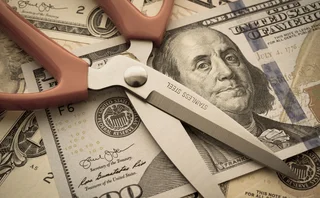Sell Algo Fuels May 6 Flash Crash
After months of sifting through mountains of trade data for May 6, 2010, the US Securities and Exchange Commission (SEC) and the US Commodity Futures Trading Commission (CFTC) issued a joint report concluding that the Flash Crash was triggered by a buy-side trader who was attempting to hedge an existing equity position by selling off 75,000 e-mini contracts. Rather than executing the trade as a block order, turning it over to a futures commission merchant (FCM) to manage, or managing the trade personally, the trader chose to use an algorithm that fed orders to the market at the rate of 9 percent of the previous minute's trading volume, regardless of price or time, within 20 minutes, according to regulators.
The immediate result was that the high-frequency traders trading in the market were able to absorb the initial influx of liquidity for the first nine minutes before aggressively selling off their long positions in the next three minutes. This added volume caused the buy-side algorithm to become more aggressive with its own trading volume.
For the next minute-and-a-half, high-frequency traders volleyed positions back and forth among one another since the market lacked enough interest from fundamental buyers to absorb the liquidity until the Chicago Mercantile Exchange's (CME’s) Stop Logic Functionality kicked in, allowing the e-mini market to stop trading, regain some support and recover.
Meanwhile, in the equity markets, many liquidity providers, including high-frequency traders, began holding back liquidity after safety thresholds in their own trading systems began to kick in. Compounding the issue were the trade internalizers, who decided to route most of their order flow to the displayed market instead of taking the other side of the trade. The lack of liquidity led to trades being executed at stub-quote levels, with some being lower than a penny and others being as high as $100,000. Approximately 8,000 equities saw their prices drop between 5 and 15 percent.
Moving Forward
One lesson learned from the Flash Crash is that high trading volume does not equate to a liquid market, according to the regulators. "Interaction between automated execution programs and algorithmic trading strategies can quickly erode liquidity and result in disorderly markets," according to the report. Other lessons include acknowledgement that many traders use the futures and equities markets for price discovery and that there should be more harmonization between the markets when it comes to circuit-breaker levels and that when market-makers withdraw from the markets, orders will be executed at stub-quote levels.
To prevent a replay of the May 6 events, the SEC worked with the Financial Industry Regulatory Authority (Finra) to establish a circuit breaker pilot program in June, as well as a new pilot program for trade-breaking procedures that began in September.
The most important thing to take away from the report is that high-frequency traders were not responsible for the events, says Paul Zubulake, a senior analyst at research firm Aite Group. "And there was no market manipulation," he adds.
Industry watchers don’t know whether or not the SEC and CFTC will be able to prevent future similar occurrences.
"The risk of a future flash crash cannot be regulated away without extreme measures that curtail innovation. But the likelihood of a flash crash can be reduced and the ability to manage through another flash cash can be improved," says Stephen Bruel, research director for the securities and investment practice at industry analyst firm TowerGroup. "Eliminating stub quotes is one of the few concrete actions that is relatively easy to implement. Creating more common rules across asset classes, exchanges and geographies will be an order of magnitude more complex."
Only users who have a paid subscription or are part of a corporate subscription are able to print or copy content.
To access these options, along with all other subscription benefits, please contact info@waterstechnology.com or view our subscription options here: https://subscriptions.waterstechnology.com/subscribe
You are currently unable to print this content. Please contact info@waterstechnology.com to find out more.
You are currently unable to copy this content. Please contact info@waterstechnology.com to find out more.
Copyright Infopro Digital Limited. All rights reserved.
As outlined in our terms and conditions, https://www.infopro-digital.com/terms-and-conditions/subscriptions/ (point 2.4), printing is limited to a single copy.
If you would like to purchase additional rights please email info@waterstechnology.com
Copyright Infopro Digital Limited. All rights reserved.
You may share this content using our article tools. As outlined in our terms and conditions, https://www.infopro-digital.com/terms-and-conditions/subscriptions/ (clause 2.4), an Authorised User may only make one copy of the materials for their own personal use. You must also comply with the restrictions in clause 2.5.
If you would like to purchase additional rights please email info@waterstechnology.com
More on Trading Tech
RBC takes European traders to the Endgame
The Canadian bank’s complex execution algorithm, increasingly popular with traders stateside, is making landfall in Europe. But the region’s fragmented markets mean adoption is not simply a matter of plug-and-play.
Banks hope new axe platform will cut bond trading costs
Dealer-backed TP Icap venture aims to disrupt dominant trio of Bloomberg, MarketAxess and Tradeweb.
Editor’s Picks: Our best from 2025
Anthony Malakian picks out 10 stories from the past 12 months that set the stage for the new year.
The next phase of AI in capital markets: from generative to agentic
A look at some of the more interesting projects involving advanced forms of AI from the past year.
Will overnight trading in equity markets expand next year? It’s complicated.
The potential for expanded overnight trading in US equity markets sparked debate this year, whether people liked it or not.
WatersTechnology latest edition
Check out our latest edition, plus more than 13 years of our best content.
The total portfolio approach gains momentum: Building the right tech foundation for success
The rationale for the TPA, and the crucial role technology plays in enabling such an approach
Google, CME say they’ve proved cloud can support HFT—now what?
After demonstrating in September that ultra-low-latency trading can be facilitated in the cloud, the exchange and tech giant are hoping to see barriers to entry come down.







